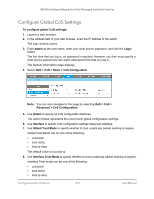Netgear XSM4324FS User Manual - Page 471
Quality of Service Overview, Manage Class of Service
 |
View all Netgear XSM4324FS manuals
Add to My Manuals
Save this manual to your list of manuals |
Page 471 highlights
M4300 Intelligent Edge Series Fully Managed Stackable Switches Quality of Service Overview In a typical switch, each physical port consists of one or more queues for transmitting packets on the attached network. Multiple queues per port are often provided to give preference to certain packets over others based on user-defined criteria. When a packet is queued for transmission in a port, the rate at which it is serviced depends on how the queue is configured and possibly the amount of traffic present in the other queues of the port. If a delay is necessary, packets get held in the queue until the scheduler authorizes the queue for transmission. As queues become full, packets cannot be held for transmission and get dropped by the switch. QoS is a means of providing consistent, predictable data delivery by distinguishing between packets with strict timing requirements from those that are more tolerant of delay. Packets with strict timing requirements are given special treatment in a QoS-capable network. With this in mind, all elements of the network must be QoS capable. The presence of at least one node that is not QoS capable creates a deficiency in the network path and the performance of the entire packet flow is compromised. Manage Class of Service The Class of Service (CoS) queueing feature lets you directly configure certain aspects of switch queueing. This provides the desired QoS behavior for different types of network traffic when the complexities of DiffServ are not required. The priority of a packet arriving at an interface can be used to steer the packet to the appropriate outbound CoS queue through a mapping table. CoS queue characteristics that affect queue mapping, such as minimum guaranteed bandwidth or transmission rate shaping, are user-configurable at the queue (or port) level. Eight queues per port are supported. Use CoS to set the Class of Service trust mode of an interface. Each port in the switch can be configured to trust one of the packet fields (802.1p or IP DSCP), or to not trust any packet's priority designation (untrusted mode). If the port is set to a trusted mode, it uses a mapping table appropriate for the trusted field being used. This mapping table indicates the CoS queue to which the packet is forwarded on the appropriate egress ports. Of course, the trusted field must exist in the packet for the mapping table to be of any use, so there are default actions performed when this is not the case. These actions involve directing the packet to a specific CoS level configured for the ingress port as a whole, based on the existing port default priority as mapped to a traffic class by the current 802.1p mapping table. Alternatively, when a port is configured as untrusted, it does not trust any incoming packet priority designation and uses the port default priority value instead. All packets arriving at the ingress of an untrusted port are directed to a specific CoS queue on the appropriate egress port(s), in accordance with the configured default priority of the ingress port. This process is also used for cases where a trusted port mapping cannot be honored, such as when a non-IP packet arrives at a port configured to trust the IP DSCP value. Configure Quality of Service 471 User Manual















